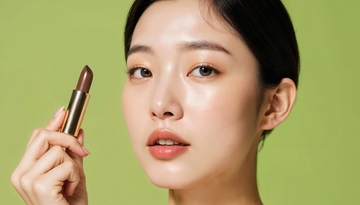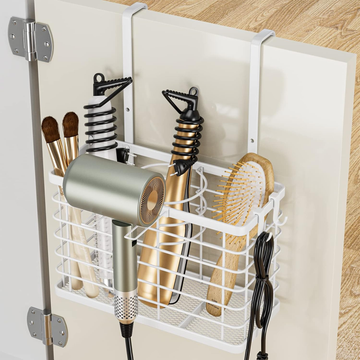Welcome to the ultimate guide for straightening your hair every single day without sending it into a frenzy of frizz. If you've ever battled with your hair in the morning, trying to tame your waves or curls into submission, only to end up with a dry, brittle mess, you're in the right place.
We're diving into the secrets of achieving sleek, straight locks, sans damage. Get ready to explore tips, tricks, and techniques to keep your mane looking fabulous without sacrificing the health of your strands.
Does straightening your hair cause damage?
When you apply heat to your hair through straightening, the high temperatures disrupt the hydrogen bonds that give your hair its natural shape, whether wavy, curly, or coiled. This process temporarily alters the structure of your hair, allowing you to reshape it.
However, this heat also damages the protective outer layer of your hair, known as the cuticle. The heat breaks down the proteins within the hair shaft, leading to moisture loss and weakening the hair's structure. Over time, this can result in dryness, brittleness, and increased susceptibility to breakage and split ends.
On top of that, excessive heat exposure can lead to long-term damage, like protein loss and structural changes within the hair shaft. This can manifest as rough texture, loss of elasticity, and ultimately, irreversible damage to your hair.
Don't lose hope, though! By taking the right approach and using things like heat protectants, you can significantly minimize the damage caused by straightening and still get the look you love. It's all about finding that delicate balance between style and hair health.
How often should you straighten your hair?
Ah, the burning question: how often can you straighten your hair without causing damage? The answer is — while it can be tempting to straighten your hair every day for that sleek, polished look — it's best to give your locks a breather.
Of course, the ideal frequency varies depending on your hair type and its resilience to heat. If your hair is fine or prone to dryness, it’s a good idea to straighten it less often to prevent damage. On the other hand, if your hair is thicker, you might be able to get away with straightening more frequently.
Ultimately, listen to your hair. Pay attention to how it looks and feels after straightening, and adjust your styling routine accordingly. And remember, embracing your hair's natural texture every now and then can be a refreshing change and a great break from the heat.
How to limit the damage straightening your hair can cause

Ready to straighten your hair? Here are some handy tips to help you minimize damage.
Wash your hair with the right shampoo
When it comes to safeguarding your strands during heat styling, look for products that contain ingredients specifically formulated to shield your hair.
First up, your shampoo should be cleansing without stripping away too much moisture. Opt for shampoos labeled "moisturizing" or "hydrating" to help keep your hair nourished and resilient. Ingredients like panthenol (pro-vitamin B5) and argan oil can also work wonders in maintaining moisture levels and strengthening your hair.
As for conditioner, go for one that's rich in emollients and proteins to fortify your hair and protect it from heat damage. Ingredients like hydrolyzed keratin, silk protein, and ceramides can help strengthen the hair shaft and provide a protective barrier against heat. Look for conditioners labeled as "thermal protectant" or "heat protectant" for that extra shield against styling tools.
And here's a pro tip: leave-in conditioners or heat protectant sprays can offer an additional layer of defense before you break out the straightener or blow dryer. These products help to coat the hair, providing a barrier against heat while also adding moisture and shine.
Make sure your hair is completely dry
When it comes to straightening your hair, moisture is not your friend. Wet or damp hair is more vulnerable to damage from heat styling because the water inside the hair shaft can turn into steam when exposed to high temperatures. This steam can cause bubbles or blisters to form within the hair, weakening its structure and leading to breakage.
Additionally, wet hair has a higher elasticity, meaning it can stretch more easily. When you apply heat to wet hair, you're essentially stretching it beyond its natural capacity, and that can lead to irreversible damage, like breakage or split ends.
Dry hair also allows the heat from your straightener to evenly penetrate the hair shaft, resulting in smoother, sleeker results with less risk of damage.
Protect your hair through the whole process
Here's how to give your hair the VIP treatment before applying any heat, and tips when you get to the actual straightening.
- Start with clean hair. Begin by washing your hair with that moisturizing shampoo and conditioner combo.
- Towel dry gently. After washing, gently towel-dry your hair to remove excess moisture. Avoid rough towel-drying, as this can cause friction and potential damage to the hair cuticle.
- Apply a heat protectant: Run a heat protectant spray or serum evenly throughout your hair, focusing on the mid-lengths and ends.
- Detangle with care: Use a wide-tooth comb or a detangling brush to gently remove any knots or tangles from your hair. Start from the ends and work your way up to the roots to minimize breakage.
- Divide and conquer: Section your hair into manageable parts using clips or hair ties. This makes it easier to make sure that each section gets evenly straightened and reduces the need for multiple passes with the straightener, which can cause unnecessary damage.
- Adjust your straightener: Set your flat iron to the appropriate heat setting for your hair type. Fine or damaged hair should use lower heat settings, while thicker or coarser hair can handle higher temperatures. Always start with a lower temperature and gradually increase if needed.
- Straighten with care: Take small sections of hair and run the straightener down each section slowly and smoothly. Avoid going over the same section repeatedly.
- Cool down: Allow your hair to cool completely before doing any further styling. This helps to set the straightened style and reduces the risk of frizz.
- Finish with a serum or oil: Once your hair is straightened, apply a small amount of smoothing serum or hair oil to add shine and tame any flyaways. Focus on the mid-lengths and ends, avoiding the roots to prevent weighing down your hair.
Use good quality hot tools
Let's break down what separates the mediocre straighteners from the best of the best.
Adjustable heat settings. A good quality straightener should have adjustable heat settings to cater to different hair types and styling needs. Having control over the heat allows you to minimize damage while achieving your desired style.
Even heat distribution. Look for straighteners with advanced heating technology that ensures even heat distribution across the plates. Uneven heat can lead to hot spots, causing damage to your hair and resulting in an uneven straightening effect.
High-quality plates. The material and quality of the plates are crucial. Ceramic, tourmaline, and titanium plates are popular choices. In our opinion, titanium plates are the best. They heat up quickly and evenly, making them ideal for thick or coarse hair.
Fast heating. Nobody wants to wait around for their straightener to heat up. A good quality straightener should heat up quickly, saving you time and energy.
Size and weight. Consider the size and weight of the straightener, especially if you plan to travel with it frequently or have long styling sessions. A lightweight and compact straightener can be more comfortable to use and store.
By considering these factors, you can find a straightener that not only straightens your hair flawlessly, it also keeps your hair healthy and happy in the long run.
Give your hair a break

Heat styling, whether it's straightening, curling, or blow-drying, can cause cumulative damage over time. Regular exposure to high temperatures can weaken the hair shaft, leading to dryness, breakage, and split ends. By taking breaks from heat styling, even just one or two days a week, you give your hair a chance to recover and repair itself.
Ultimately, giving your hair a break from heat styling promotes its overall health and vitality. It's like a mini-vacation for your locks, allowing them to rejuvenate and thrive. Your locks will thank you for the TLC with improved strength, shine, and resilience.
Time to straighten your hair… then straighten it again
Now that you’re armed with the best tools and products for the job, go forth and straighten your hair as often as you like. But if you can skip a day here or there and let your natural texture shine, we love that for you, too.





